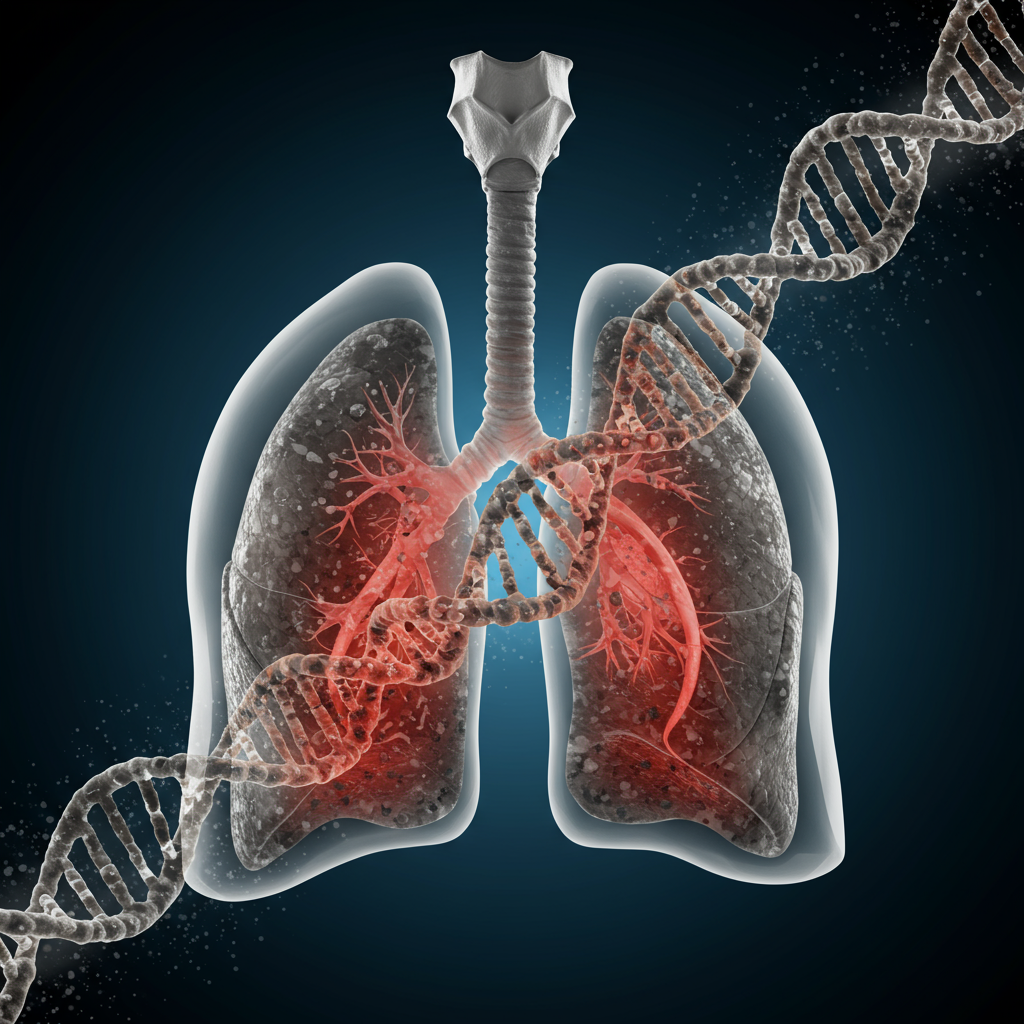Lung cancer, tragically, remains a leading cause of cancer death globally. While smoking is the most well-known culprit, a puzzling and concerning trend has emerged: increasing diagnoses among individuals who have never smoked. For years, scientists have suspected environmental factors like air pollution play a role, but the exact biological connection remained elusive.
Now, groundbreaking new research provides compelling genomic evidence. A large-scale international study has found a strong association between exposure to outdoor air pollution – specifically fine particulate matter from sources like traffic and industry – and specific DNA mutations found in the lung tumors of never-smokers. This research details how smog and soot may act as potent carcinogens, driving tumor growth through mechanisms previously linked primarily to tobacco smoke.
Uncovering the Genomic Link: The Sherlock-Lung Study
The extensive investigation, part of the “Sherlock-Lung” study, represents the largest whole-genome analysis focusing specifically on lung cancer in individuals with minimal or no smoking history. Researchers from leading institutions, including the U.S. National Institutes of Health (NIH), the National Cancer Institute (NCI), and the University of California San Diego (UCSD), collaborated on this project.
They analyzed the complete genetic code of lung tumors taken from 871 patients across 28 distinct geographic locations spanning four continents: Africa, Asia, Europe, and North America. All participants had lung cancer despite having never smoked (defined as smoking fewer than 100 cigarettes in their lifetime) and had not yet received cancer treatment.
Key DNA Damage Linked to Pollution Exposure
By correlating the genomic data from the tumors with estimated levels of long-term air pollution exposure in the patients’ regions, the scientists uncovered a striking pattern. They found a significant relationship between higher levels of fine particulate pollution and an increased number of specific genetic mutations within the lung tumors.
These mutations included alterations in critical genes like TP53 and EGFR. These genes are considered hallmarks of lung cancers and are frequently mutated in cancers driven by tobacco smoking. The study provides molecular evidence that air pollution can induce similar cancer-promoting damage.
Specific Mutational Signatures Reveal Pollution’s Impact
The analysis went deeper, identifying distinct “mutational signatures” – characteristic patterns of DNA damage left behind by specific exposures. The study found strong associations between pollution exposure and signatures previously linked to tobacco smoking, particularly one known as SBS4.
Never-smokers living in areas with higher air pollution were nearly four times more likely to exhibit the SBS4 signature in their tumors compared to those in regions with cleaner air. This suggests air pollution is driving the same type of genetic damage seen in smokers, even without direct tobacco exposure.
Pollution exposure also correlated with a significant increase (76%) in an aging-related mutational signature, further highlighting its detrimental impact on cellular health.
Beyond Mutations: Pollution’s Impact on Telomeres
The study also revealed another concerning biological effect. Higher levels of air pollution were associated with shorter telomeres in tumor cells. Telomeres are protective caps on the ends of chromosomes that naturally shorten with age.
Premature telomere shortening is a marker associated with accelerated cellular aging and increased cell division rates, which are characteristics of cancer growth. This finding suggests that air pollution may not only induce mutations but also accelerate the cellular processes that contribute to tumor development.
Air Pollution vs. Secondhand Smoke
Interestingly, the study compared the effects of air pollution with those of secondhand tobacco smoke exposure, a known cancer risk. While secondhand smoke was associated with slightly higher overall mutation burdens and shorter telomeres, it did not show a strong link to the specific cancer-driving mutations or mutational signatures identified with air pollution.
This finding suggests that while secondhand smoke carries risk, its mutagenic effect – its ability to cause genetic mutations – appears much weaker than that of fine particulate air pollution in this context. The study authors noted that current methods might be less sensitive in detecting secondhand smoke’s mutagenic fingerprint compared to air pollution or direct smoking, although its biological impact (telomere shortening) was still evident.
A Direct Mechanism for Cancer Development
The research provides a crucial mechanistic explanation for how air pollution contributes to lung cancer in non-smokers. It suggests that fine particulate matter doesn’t necessarily create entirely new, unique mutational signatures but rather increases the frequency of mutations within known DNA damage pathways.
Essentially, breathing polluted air appears to trigger tumor growth by inducing genetic damage and accelerating cellular aging in ways comparable to the chemicals in cigarettes. A clear dose-response relationship was observed: the greater a person’s likely exposure to pollution based on where they lived, the more mutations and shorter telomeres were found in their lung tumors.
Other Environmental Factors Emerge
Beyond air pollution, the Sherlock-Lung study also shed light on other potential environmental risks for never-smokers. The researchers identified a specific mutational signature associated with aristolochic acid, a compound found in certain traditional Chinese herbal medicines.
This signature was found almost exclusively in lung cancer cases of never-smokers from Taiwan. While aristolochic acid was previously linked to cancers from ingestion, this is the first genomic evidence suggesting a potential link to lung cancer, possibly through inhalation. This finding highlights a potential public health opportunity to prevent cancer by raising awareness about the risks associated with certain herbal medicines.
Intriguingly, the team also discovered a novel mutational signature present in a majority (28%) of the never-smoker lung cancers studied. This signature, SBS40a, was absent in smokers and did not correlate with air pollution or other known exposures. Its cause remains unknown and is the subject of ongoing intensive investigation, representing an entirely new area of research into never-smoker lung cancer.
Addressing a Growing Global Problem
The rising incidence of lung cancer in never-smokers, which now accounts for an estimated 10% to 25% of all cases globally, is an urgent public health challenge. This trend is particularly notable in regions with high air pollution, such as East Asia, where the highest rates of adenocarcinoma attributable to pollution are concentrated. Even in areas with lower pollution levels, like the UK, air pollution is still estimated to contribute to a significant number of new diagnoses annually. China, with its combined challenges of smoking and air pollution, faces over a million lung cancer deaths each year.
This study provides critical genomic evidence supporting the need to address air quality as a major environmental carcinogen directly contributing to lung cancer burden worldwide, particularly in populations previously thought to be at lower risk. Understanding these mechanisms is vital for developing effective prevention strategies for this vulnerable group.
Limitations and Future Research
The researchers acknowledge certain limitations in the study. Relying on regional air pollution data, while necessary for a study of this scale, cannot capture the precise exposure levels of any single individual. Additionally, participants self-reported their smoking history, and there’s a possibility some may have smoked more than they reported.
Despite these limitations, the consistency of the findings across a large, diverse cohort strengthens the conclusions. The team plans to expand their research to include a more diverse global population and gather more detailed local pollution data. They also aim to investigate other potential environmental exposures that might contribute to lung cancer in never-smokers, including marijuana smoke, e-cigarettes, radon, and asbestos.
The genomic evidence from this study provides a powerful new layer of understanding regarding the complex causes of lung cancer in people who have never smoked. It underscores that “never-smoker lung cancer” is not a single disease but likely a collection of cancers driven by various environmental exposures, including air pollution, and potentially other unknown factors.
Frequently Asked Questions
What specific DNA changes are linked to air pollution in non-smokers?
The study found that air pollution exposure is strongly associated with an increase in specific DNA mutations and mutational signatures in the lung tumors of never-smokers. These include mutations in genes like TP53 and EGFR, which are common drivers of lung cancer. Air pollution is also linked to the SBS4 mutational signature, previously associated with tobacco smoking, and an aging-related signature. Additionally, the study observed shorter telomeres, protective DNA structures, in tumor cells from individuals exposed to higher pollution, indicating accelerated cellular aging.
Where can I learn more about the Sherlock-Lung study findings or related research?
The primary findings of this study, part of the larger Sherlock-Lung project, were published in the prestigious journal Nature in July 2025. Further information about the research may be available through the collaborating institutions, including the U.S. National Institutes of Health (NIH), the National Cancer Institute (NCI), and the University of California San Diego (UCSD). These institutions often release news summaries and publications related to the study.
How does this study impact the urgency of reducing air pollution for health?
This study provides compelling genomic evidence that air pollution is not just a respiratory irritant but a direct carcinogen that causes specific DNA mutations driving lung cancer, particularly in people who have never smoked. By detailing the molecular mechanisms, the research strengthens the scientific basis for linking pollution to cancer. This underscores the urgent necessity for governments, industries, and individuals globally to implement stricter environmental regulations and reduce emissions to protect public health and lower cancer rates.
Conclusion
This groundbreaking study marks a significant step forward in understanding the rising incidence of lung cancer among never-smokers. By providing detailed genomic evidence, it confirms that air pollution is a critical environmental carcinogen, driving specific DNA mutations and accelerating cellular aging in lung tissue. While tobacco control remains paramount, these findings underscore the urgent need to address air quality as a global health priority. As researchers continue to uncover other potential drivers of never-smoker lung cancer, this work paves the way for more targeted prevention strategies and reinforces the importance of environmental protection in the fight against cancer.



